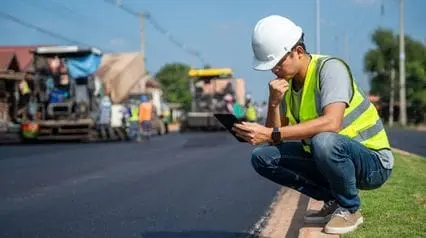What is a Road Safety Audit?
A Road Safety Audit (RSA) measures the safety performance of an existing or future road or intersection to reduce potential accidents. RSA can be conducted at various road or highway project stages, such as during the planning, design, or construction phases.
Road analysis takes into account their operational characteristics and design elements. A team of experts usually conducts the audit process, which assesses risk factors and recommends improvements. The assessment consists of an examination from the perspective of pedestrians and vehicular users, including cyclists.
Benefits
There are many benefits associated with carrying out a road safety audit. These include:
- Produce designs that reduce accidents and their severity
- Prevent safety issues before projects are built may reduce costs
- Raise awareness of safe design practices
- Consider multimodal safety during designing
- Incorporate human factors into every aspect of the design
How to Prepare for RSAs
Before conducting a road safety audit, planning and gathering the right team is required. It’s important to know the steps to be taken before, during, and after the audit. Here are some tips on what to prepare and do when conducting road safety audits:
1. Determine the Objective
Knowing the objective will help in building the right auditing team and coming up with a plan of action for the road safety audit. It’s also important to know, at the onset, if the audit is for a new road or an existing intersection where accidents have been reported to happen. This information will determine how the road safety audit will go.
2. Build a Team
Depending on the objective, the auditing team members’ fields of expertise can vary. A road safety auditing team can comprise road safety specialists, highway engineers, traffic operations specialists, and a local contact person (e.g., local police officer). Assembling a multidisciplinary team is beneficial because varying perspectives can help in future road safety design. After building the team and before conducting the audit, members should meet and discuss how best to proceed with the road safety audit.
3. Conduct the Audit
The audit team will conduct the audit in different conditions and times of day to identify all apparent and potential road safety concerns. Team members will collect photos and data on possible road risks and causes of accidents. Because weather and road conditions can be unpredictable, it is important to bring the right tools and wear Personal Protective Equipment (PPE) before going to the site.
4. Prepare the Audit Report
After the audit, the team will organize and analyze all photos and data collected. They will collate relevant data to be included in the road safety audit report together with their recommendations. The report is then submitted as a single document to the project head or party who requested the audit.
Road Safety Audit Process
The process of carrying out a road safety audit follows several steps:
Step 1: Identifying the Project
A project manager should evaluate the impact of each road project on the road network to maintain a trackable record of the selection criteria for road projects that need to be audited. When an RSA is determined to be necessary for a project, the client organization’s project manager should specify the following conditions in their safety audit brief:
- Safety audit scope
- The timeframe for completing the audit
- The requirements for a road safety audit team
- The audit’s report format
- Expectations for decision tracking forms
Step 2: Selecting the Road Safety Audit Team
Project managers and safety engineers should collaborate to select a road safety audit team appropriate for the road project being audited. Road safety auditors should be people outside the design organization to ensure impartiality and objectivity.
Step 3: Pre-Audit Briefing
The project manager should create an audit brief for the road safety auditors with appropriate project information, such as the parameters identified during Step 1. The brief should include recommendations regarding what should be included in the audit and provide an opportunity to ask for additional information.
Step 4: Studying and Reviewing Drawings
Before visiting the site, the road safety auditors must review design drawings and other provided information for all stages of the RSA. This review is essential to understand how road users could interpret the planned project and possible safety issues.
Additional data must accompany the designs to help measure the project’s safety against current practices. Comments should only concern road user and operator safety.
Step 5: Visiting the Site
The road safety auditors must conduct a risk assessment before visiting the site. All team members must use the necessary Personal Protection Equipment (PPE) during the site inspection.
The team should verify the issues identified in Step 4 during the site visit and record any additional issues. Photographic or video evidence should be used when writing the audit report and debriefing.
Peak-hour visits and observations off-peak may be required during the audit to understand how traffic interacts with the layout during these times. A visit during nighttime is also necessary to identify any visibility issues.
Step 6: Road Safety Audit Debriefing
Using the information from Step 4 and the site visit, the audit team should conclude their findings and identify ways to improve safety. They should discuss these results with the Project Manager, Design Team, and Safety Engineer. They can present their data at this meeting, including photos and video. Safety Engineers can ask questions and request more information about the audit’s findings, while the Design Team can share their actions and recommendations.
Document the minutes of the Road Safety Audit debrief meeting to prevent subjective decisions from being included in the report and to reduce the risk of misinterpretation by the Project Manager.
Step 7: Reporting
The audit team leader is responsible for the content of the audit report. Reports should be concise with clear numbered issues and written with the support of the audit team. It may be necessary to include photos or illustrations to support each case. In addition, standards, guidance, and reports should be listed where appropriate. The report must adhere to the timeframe defined in the RSAudit brief.
The audit report should be sent to the Project Manager, accompanied by a letter listing any road safety issues not covered in Step 1 of the project.
Step 8: Completing the Decision Tracking Form
After the audit report is submitted to the client, they will ask the design team to evaluate each issue and recommendation in a Decision Tracking Form. After consulting with the design team, the project manager has approved or denied the safety issue. The Decision Tracking Form should consider factors such as:
- Is the defined issue within the project scope as identified in Step 1?
- Do the road safety audit report recommendations mitigate the safety issue, reducing its probability of occurrence and severity?
- Will the recommendation result in other non-safety issues, such as mobility or the environment?
- What is the cost of implementing the recommendation? Is there a more cost-effective alternative?
Those items outside the project scope described in Step 1 should be referred to the appropriate authority or organization by the Project Manager.
To reduce safety risks, the project manager or the design team should outline what actions need to be taken. The Decision Tracking Form should outline the reasons for rejecting a safety issue.
Submit the Decision Tracking Form to the RSA team for record-keeping upon completion. The Project Manager’s proposed actions outlined in the report should also be implemented according to the specifications of the Decision Tracking Form and established timeline.
Step 9: Audit Closure
If any issues outlined in the Decision Tracking Form warrant further consideration, the client should prepare an exception report for review by the design team and stakeholders.
The design team and stakeholders will meet to agree to the changes to the draft exceptions report before releasing the final exceptions report to the audit team and the client.
The exception reports, decision tracking forms, and RSA Reports are stored as evidence of the road safety audit process.
FAQs About Road Safety Audit
It is common practice in the United Kingdom and Australia to conduct road safety audits, which are now becoming more widespread in the United States. In the UK, these are mandatory for all trunk roads (including motorways). Section GG, 119 of the Design Manual for Roads and Bridges (formerly HD19/15) provides requirements for a Road Safety Audit.
Potential safety issues identified during a Road Safety Audit include:
- Inadequate lighting
- Poor sight distances
- Insufficient signage or markings
- Unclear or confusing road layouts
- Other factors that could contribute to accidents or injuries
The audit may also identify pedestrian or bicycle safety issues, such as inadequate crosswalks or bike lanes.
Road safety is a critical issue that affects people all over the world. The World Health Organization (WHO) identifies the following issues affecting road safety:
- Unsafe vehicles and road infrastructure
- Inadequate post-crash care
- Insufficient law enforcement of traffic laws
Road safety issues can be complex and challenging to solve. It is not just a question of improving infrastructure or enforcement but also of changing attitudes and behavior. Fatalities are often the result of human error, so designing interventions that target behaviors can be challenging. In addition, there may be financial, cultural, or political barriers to implementing safety measures in certain regions.
Since road safety audits have become a key part of the Highway Safety Improvement Program (HSIP), those applying for HSIP funding are required to conduct RSAs. On the other hand, an RSA is required for 25% of design plans if all or some parts of a project are eligible for HSIP.
An independent multidisciplinary team of auditors is qualified to conduct a road safety audit. Consisting of at least two people, the team must be independent of the designer and approved by the National Roads Authority (NRA) or Local Roads Authority.
They are responsible for identifying potential safety concerns as well as areas for improvement with regard to road safety for public use.
There are various schemes needing road safety audits, including the following:
- Major road developments
- Motorway improvements
- Temporary traffic management diversions
- Pedestrian schemes
- Cycling and walking schemes
- Light rail integration schemes
- Bus priority schemes




